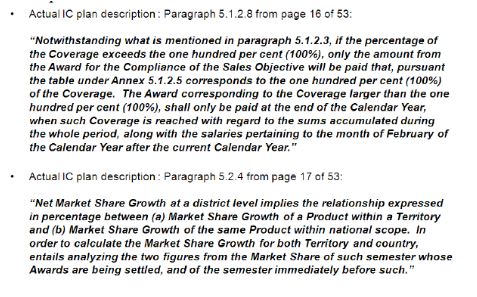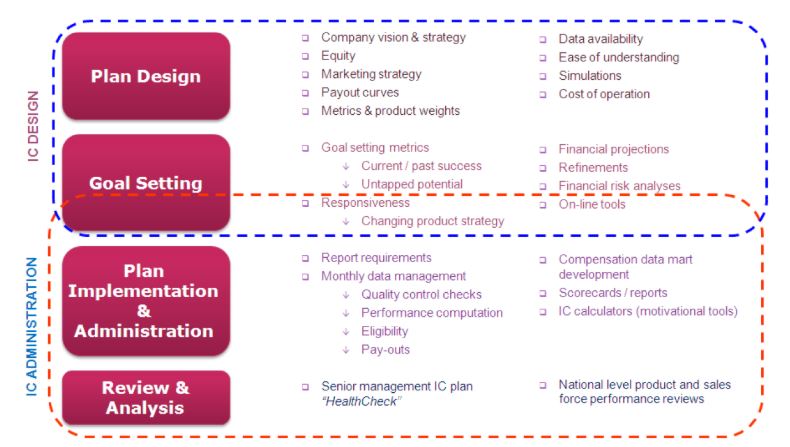
Incentive compensation is intended to be a key driver of the company success, but only if it communicates effectively the direction and strategy of growth to sales people, if it actually motivates them to move and take steps in that direction, and if it effectively, rewards people in fairness for their accomplishments, beyond market and externalities, managing financial risk. Three different objectives, managed usually by three different functions who have not always the same goal. How to assure a seamless, coherent and transparent incentive compensation - and objective plan?
Incentive compensation (IC) is an ongoing task usually managed and controlled by the commercial and HHR departments, with input from top management, the financial department and marketing management alike, who have different levels of responsibility and input throughout the yearly business cycle.
It is clear that no company is completely happy with their IC planning and administration; most IC plans are overly complicated and are not communicated effectively. Most times, changes in business strategies are not reflected in the IC plans, creating a real rupture between what management wants and what they are signalling to accomplish. This translates into what is understood as unfair plans that demoralize sales forces due to incongruence between what it is said and what it is paid. In the long term, this costs companies more money than they realize, not just due to inaccurate goal setting, but also because of higher than usual turnover, and disruption on the field.
Why IC does not make happy any of the stakeholders? There are two main reasons. The first one is that each one of the stakeholders has different objectives in mind: For the receiver (the sales force), usually it is about revenues, new accounts, and, above all, survival. For the district manager or mid management, it is about protect the base, and grow the revenue. For the financial director, it is about pushing results whilst minimizing the financial risk of missing by excess or defect the objectives. For top management, it is a method to try to push results exceeding budget, and if possible, beating forecasts. The second reason is also on the nature of the process followed, which usually excludes the final receiver of the compensation, which makes any objective setting or performance indicator proxy hence perceived as unfair, unilateral and subjective.

IC as an integral part of successful SF strategy implementation
The main goal of IC is to ensure that the company strategy is aligned with the compensation structure and relates field goals to company goals while motivating the sales force. Easier said than done! Being one of the most spiky and thorny issues and processes within the company –it involves and impacts two of the key assets of a pharma company - budget and people (the third one is products) - it would be useful to assure that the process is well defined.
In order to be most effective, transparent and objective on the process of IC, we recommend following a staged process.
- The first step, IC design, has two parts: In the first one, the plan is drafted, and in the second, the goals are set.
- The second step, IC Administration, involves a plan implementation and administration, and timely IC review and analyses.
Each one of these two stages have a very clear pathway of activities, responsibilities and milestones. The key activities to be developed for each stage and sub-step can be reviewed in the graph here below; in both stages, highly analytical, solid financially driven decisions are recommended. Whereas the plan needs to be driven top-down, bottom up inputs needs to be sturdily considered, assure that the plan design does not fall into the coldness of a financial risk-analyses exercise.

IC Plan design basics
The first question, prior to even start defining the type of IC plan that better suits the company, starts with ‘how much of pay is salary, vs incentive”? this choice is strongly related with the vision and culture of the company: do you want to promote a career-oriented sales force, how many non-selling activities are to be emphasized, what is the type of selling favoured by the type of portfolio products and their life stage? What is the type of control within the company, strategic, operational, or financial?, what is the company’s willingness to assure risk vs return?
Once that this first key question is answered, the IC design can kick-off. At this moment the question is then, “Which type of IC plan suits better the vision and commercial objectives, and, as importantly, the culture of the company? There are all types of incentive plans chosen by companies; some are intrinsic motivators, some are extrinsic in nature. Most companies rely on economical motivators, which can be defined in a variety manner. The most common IC designs are based on goals, commissions or bonus; more complex ones have elements of relative performance, self-selected objectives, or partial internal rankings, but they could be as complex as mixed (bonus + commission), matrix-based, progressive, multiple-capped and multiply measured.
The most critical step is, not on how to decide on the type of IC, but on how to define and to set objectives to measure. Something to consider is that, for each additional complexity included in the IC Design, an added risk into the objective setting is introduced in the model and the system. And the higher the uncertainty, and the number of elements included in the calculation, the lower the transparency and the most difficult to calculate the real impact of the plan on performance.
More complex plan design does not necessarily mean better or fairer; Americans got it right some time ago, and their IC plans are what is known as the “KISS” approach (Keep It Simple and Steady). Different social policies in Europe usually end with convoluted plans and mixed performance dashboards that are obscure and obsolete quickly upon changing of market conditions. If you need to change the basics of your objective setting factors every 6 months, maybe you want to consider a full revisit of the IC Plan.
IC Plan implementation basics
In order to assure a steady flow of the implementation, the first rule to observe is the documentation – everything should be elicited and shared with a strong quality control and sanity double checks. We are talking about a lot of money for a lot of people, so everything should be clearly coordinated and transparent, in addition to be timely. The manager in charge of IC should assure that responsibilities and control on the milestones of the project are shared, to avoid silos of information that frequently encourage misunderstandings. At the same time, implementation of an IC should be inflexible regarding schedules and errors; the computation of the payouts should be fully automated to assure minimum human intervention and hence mistakes, double takes or delays in the payments.
Incentive Compensation is one of the most daunting and critical of the tasks of HHRR, Finance, and Top Management -- everybody has its share of responsibility, accountability...and liability! (so please also check with your legal department); it starts with forecasting of assets (products) for objective setting, passes through assuring the right performance of assets (people) and finishes with the sustainability of more assets (revenues). Incentive Compensation and objective setting is a heavy analytical endeavour that needs objective, detached and cold head, but that touches the heart of the hottest topic and what appears usually emotional engagement in a company: The pay for performance.
For further information on best practices, on objective setting and incentive compensation, do not hesitate to contact us .

